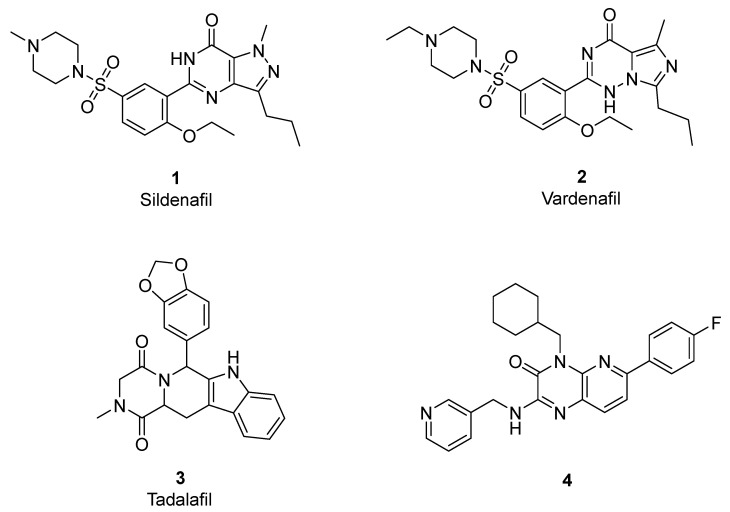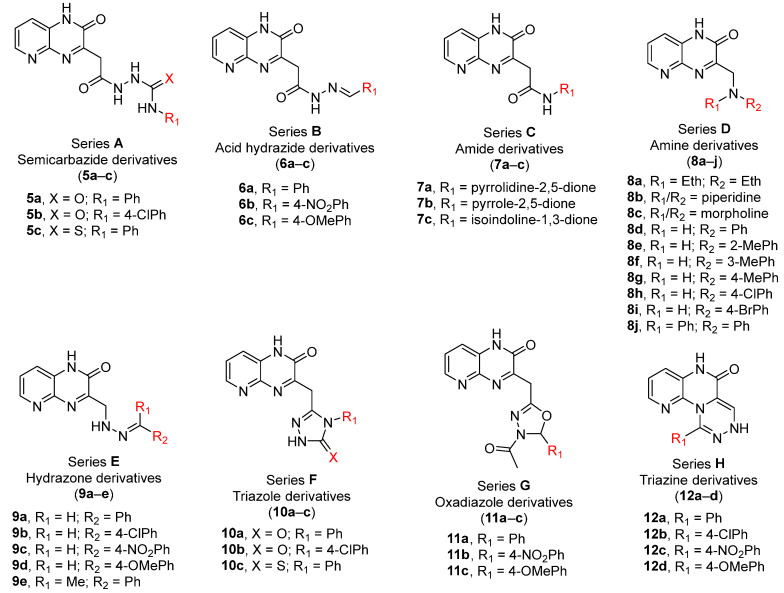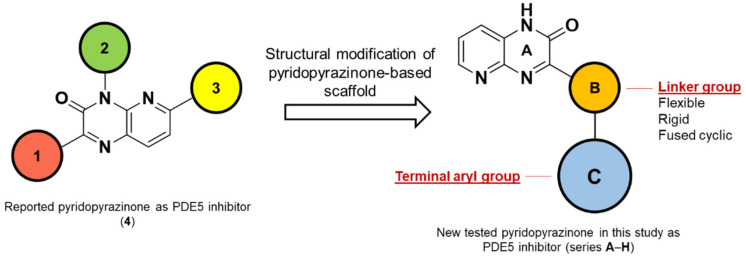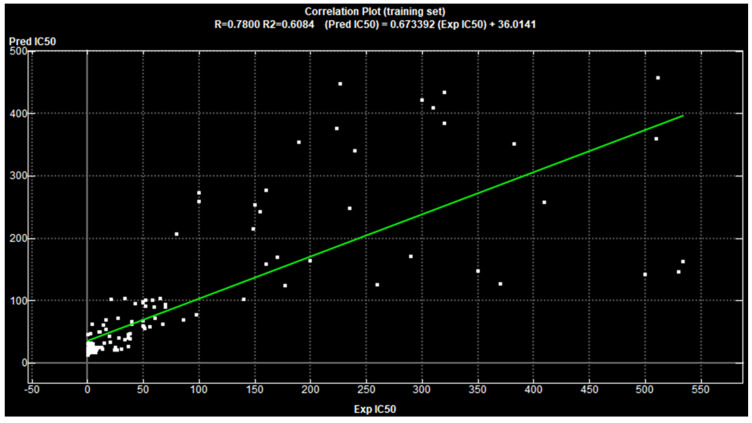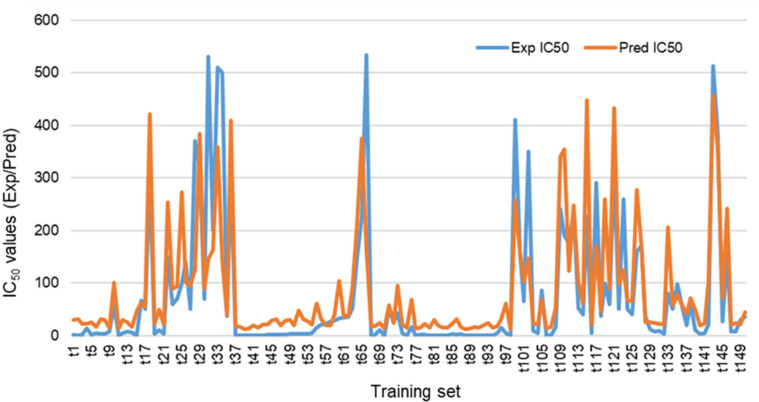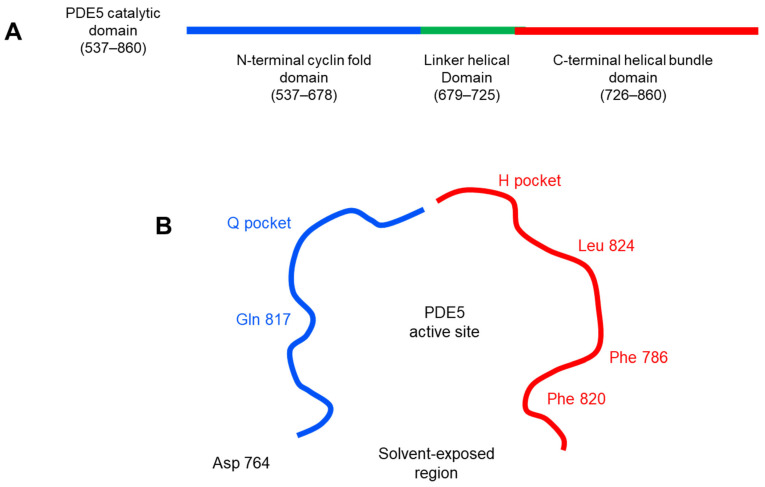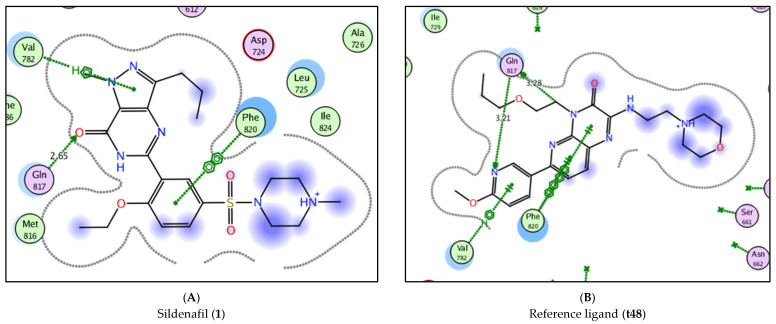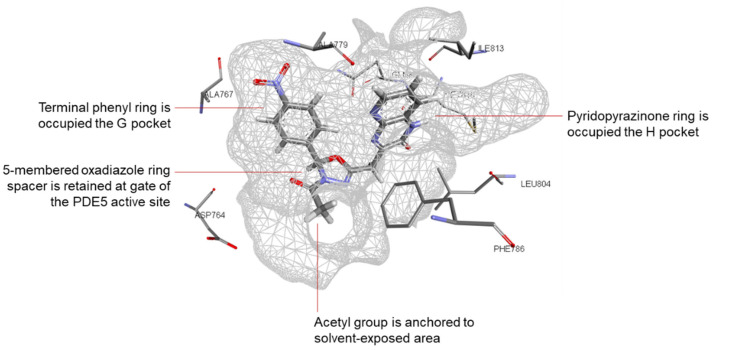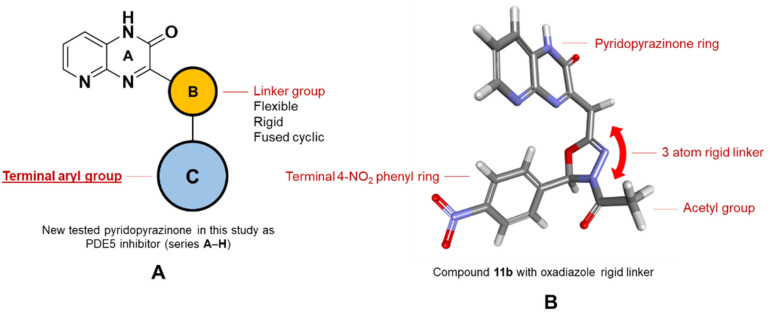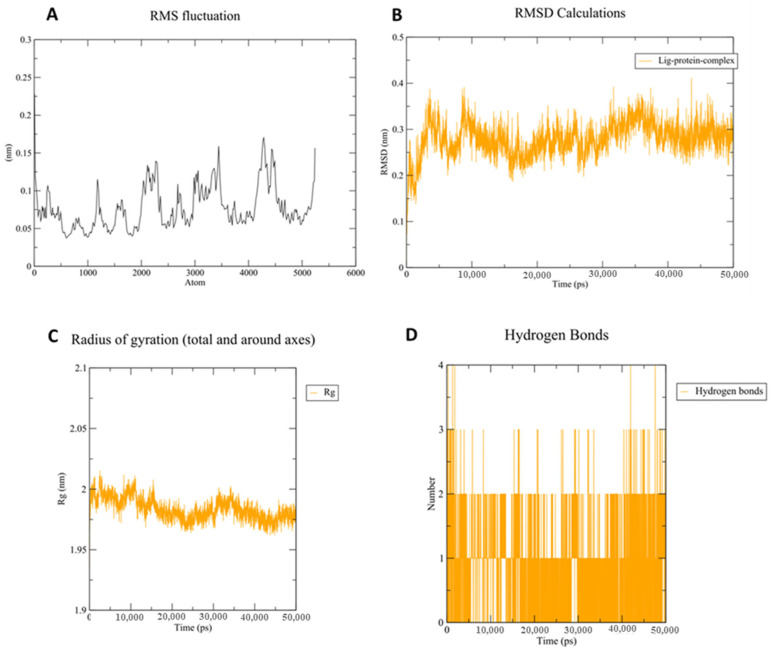Abstract
Inhibition of PDE5 results in elevation of cGMP leading to vascular relaxation and reduction in the systemic blood pressure. Therefore, PDE5 inhibitors are used as antihypertensive and antianginal agents in addition to their major use as male erectile dysfunction treatments. Previously, we developed a novel series of 34 pyridopyrazinone derivatives as anticancer agents (series A–H). Herein, a multi-step in silico approach was preliminary conducted to evaluate the predicted PDE5 inhibitory activity, followed by an in vitro biological evaluation over the enzymatic level and a detailed SAR study. The designed 2D-QSAR model which was carried out to predict the IC50 of the tested compounds revealed series B, D, E and G with nanomolar range of IC50 values (6.00–81.56 nM). A further docking simulation model was performed to investigate the binding modes within the active site of PDE5. Interestingly, most of the tested compounds showed almost the same binding modes of that of reported PDE5 inhibitors. To validate the in silico results, an in vitro enzymatic assay over PDE5 enzyme was performed for a number of the promising candidates with different substitutions. Both series E and G exhibited a potent inhibitory activity (IC50 = 18.13–41.41 nM). Compound 11b (series G, oxadiazole-based derivatives with terminal 4-NO2 substituted phenyl ring and rigid linker) was the most potent analogue with IC50 value of 18.13 nM. Structure–activity relationship (SAR) data attained for various substitutions were rationalized. Furthermore, a molecular dynamic simulation gave insights into the inhibitory activity of the most active compound (11b). Accordingly, this report presents a successful scaffold repurposing approach that reveals compound 11b as a highly potent nanomolar PDE5 inhibitor worthy of further investigation.
Keywords: PDE5 inhibitors, pyridopyrazinone derivatives, scaffold repurposing, in vitro enzyme assay, 2D-QSAR analysis, molecular docking, molecular dynamic simulation
1. Introduction
Phosphodiesterase enzyme (PDE) plays an important role in regulating the intracellular level of cyclic guanosine monophosphate (cGMP), the second messenger of nitric oxide [1,2,3,4]. cGMP is hydrolyzed by phosphodiesterase enzyme into its inactive metabolite 5′-GMP which mediates a significant elevation of intracellular calcium concentration, resulting in vascular constriction [1,5]. Eleven subtypes of phosphodiesterase family have been described (PDE1–11) [6]. PDE5 is expressed mainly in vascular smooth muscle cells, lung, kidney, and platelets [5,7,8]. Inhibition of PDE5 results in elevation of cGMP and finally leads to vascular relaxation and reduction in systemic blood pressure [9,10]. Therefore, PDE5 inhibitors can be considered potential antihypertensive and antianginal agents. Moreover, the discovery of sildenafil (1, Viagra®, PDE5 inhibitor) revealed its potential use in the treatment of male erectile dysfunction [1,5,8,11,12]. Recently, it was approved for the treatment of pulmonary hypertension (Revatio®) [1,12]. In addition, it was reported for the treatment of cardiac hypertrophy [13,14]. Further structural optimization of sildenafil has driven the development of a new PDE5 inhibitor agent such as vardenafil (2, Levitra®) [1,7,15] and tadalafil (3, Cialis®) [1,16] (Figure 1).
Figure 1.
Reported PDE5 inhibitors.
A number of scaffolds have been synthesized and evaluated as PDE5 inhibitors such as quinolone [7,17], pyridopyrazinone [1,4,7,18], phthalazine [5], pyrazolopyrmidinone [19,20], β-carboline [6,21], 1,3-benzodioxole [6,22], imidazotriazinone [21,23] and pyrroloquinolone derivatives [24]. Among them is the pyridopyrazinone derivative (compound 4) [1] (Figure 1). Pyridopyrazinone-based scaffold has a wide spectrum of biological activities in the field of medicinal chemistry. It can act as CRF-R1 antagonist [25,26,27,28,29], PI3K inhibitor [30,31,32] and antiproliferative agent [30,33,34,35,36,37,38]. Pfizer Global R&D described and evaluated a new series of tri-substituted pyridopyrazinone derivatives for their PDE5 inhibitory activities (compounds t37–93) [1,4] (Table S1). Recently, we also described the synthesis and biological evaluation of a novel series of mono-substituted pyrido [2,3-b]pyrazinone derivatives as anticancer agents (series A–H) [39,40] (Figure 2, Schemes S1 and S2 and Table S2). Our goal was to evaluate these candidates (series A–H) as potential PDE5 inhibitors since they shared the same structural and molecular features of pyridopyrazinone core scaffold in the previously reported PDE5 inhibitors invented by Pfizer Global R&D. In addition, the new structural combination and orientation will be evaluated and compared with that of previously reported PDE5 inhibitors (Figure 3). In the reported PDE5 inhibitors, pyridopyrazinone ring was designed to be the central scaffold in which it was decorated with multiple aryl substitutions (group 1–3, left-hand side in Figure 3) with different size. The new tested compounds were divided into 3 motifs (right-hand side in Figure 3); central linker group (B) and 2 terminal binding motifs (core pyridopyrazinone ring, A; and terminal aryl group, C). The linker group (B) may be flexible spacer with different atom lengths (series A–E); rigid five-membered rings (series F and G); and fused cyclic system (series H).
Figure 2.
The tested pyridopyrazinone derivatives. Eight different series (A–H) with structural variation in the spacers between the core pyridopyrazinone scaffold and the terminal aryl motif. Series A–E with flexible spacer with different length as well as different incorporated HBD/HBA atoms. Series F and G with 5-membered rigid spacers (triazole and oxadiazole, respectively). Series H with rigid tricyclic system. (Table S2).
Figure 3.
Rational structural modification of the reported pyridopyrazinone-based derivatives as PDE5 inhibitors. The orientation of the terminal groups is modified structurally. In the reported inhibitors, pyridopyrazinone scaffold is designed to be the central motif. In the tested compounds, the pyridopyrazinone ring is functioning as one of binding motifs.
2. Materials and Methods
2.1. Chemistry
The tested compounds were synthesized as reported in our previous publications [39,40]. The experimental method and full characterization for both key intermediates (IV, VII and VIII) and final compounds (series A–H) are cited in the Supplementary Materials (Section S4). General methods for the chemical experiments were carried out as previously reported [39,40].
2.2. In-Silico Screening
The in-silico screening of the pyridopyrazinone derivatives (training set, t1–150 and test set, series A–H) was conducted using MOE (Molecular Operating Environment) software [41] through Windows 10 operating system.
2.2.1. 2D-QSAR Analysis
The 2D-QSAR analysis was designed based on the linear regression model. The procedure for generating the 2D-QSAR model was summarized in the following steps:
Assembling the Database for the Training Set and Test Set
Both molecular structures of training set (t1–150) and the test set (series A–H) were drawn using ChemDraw software. The molecular structures were migrated to MOE software. The migrated molecular structures were 3D protonated and minimized using MOE tools then loaded to separate databases. The experimental PDE5 IC50 values of the training set were presented in the training set database.
Calculating the 2D-Descriptors
Eighteen 2D-atomic contribution model descriptors were selected and calculated for the training set (log of the octanol/water partition coefficient, SlogP and molar refractivity, SMR)
Pruning the Proposed 2D-Descriptors
The calculated set of 2D-descriptors were pruned in order to filter the optimum set for the molecules under consideration (training set). QSAR contingency analysis was conducted to filter the appropriate descriptors for the designed model. A recommended set of 2D-descriptors was defined according to a number of statistical values. Seventeen 2D-descriptors were finally filtered to be used for the proposed 2D-QSAR model.
Fitting the Experimental IC50 Values
The 2D-QSAR model has been run with partial least squares (PLS) as model fitting procedure and was conducted to the training set in order to fit the dependent variables (IC50) to the independent variables (calculated 2D-descriptors) using linear regression analysis.
Cross Validating the Designed Model
The 2D-QSAR model was validated using leave-one-out method (LOO) in order to identify the predicted IC50 and residuals.
Estimating the Predicted IC50 of the Test Set
The IC50 values of the test set (series A–H) were predicted using the assembled fit model obtained from the training set analysis. The predicted results were used to build a rational structure activity relationship (SAR).
2.2.2. Molecular Docking
The X-ray structure of phosphodiesterase enzyme type 5 (PDE5) domain with its reference ligand (t48) was downloaded from the protein databank RCSB PDB (PDB ID: 3HC8) [4]. The X-ray structure of PDE5 was visualized and manipulated by MOE (Molecular Operating Environment).
The experimental protocol of molecular docking screening is cited in Supplementary Materials (Section S5) and was performed as described in our previous publication [42].
2.3. In Vitro Enzyme Assay
Tested compounds (series B, D, E and G) were tested against phosphodiesterase enzyme type 5 (PDE5) in order to investigate their inhibitory activities. The in vitro enzyme assay was conducted using Transcreener Fluorescence polarization assay [43] to detect the reaction product GMP. The compounds were suspended in DMSO to make 10 mM stock solutions. The procedure was conducted using the following buffer system; 10 mM Tris, pH 7.5, 5 mM MgCl2, 0.01% Brij 35, 1 mM DTT and 1% DMSO. The tested compounds were evaluated in a 10-dose IC50 with 3-fold serial dilution starting at 50 uM against methoxyquinazoline as standard control. The tested samples were added into the enzyme by Acoustic Technology. The substrate was added and incubated for 1 h. Fluorescence polarization (FP) was measured after 90 min incubation at rt and mP was calculated. Data were analyzed based on the GMP standard curve.
2.4. Molecular Dynamic (MD) Simulation
Protein-ligand complex MD simulation was conducted to validate the molecular docking results. The binding complex of the most potent derivatives among the tested compounds (11b) was selected for molecular dynamic analysis. The crystal structure of the human PDE5 in complex with t48 (PDB ID: 3HC8 [4]) was used as a control.
The experimental protocol of molecular dynamic simulation is cited in the Supplementary Materials (Section S6) and was performed as addressed in our previous publication [44].
3. Results and Discussion
3.1. In-Silico Screening
Before conducting the in vitro wet-lab analysis for the tested compounds (series A–H), in-silico screening studies will be performed to predict the target activity as well as to minimize the test set for further in vitro investigation. More than a hundred PDE5 inhibitors were reported in the literature with their IC50 values. Therefore, 2D-QSAR analysis was selected as a predictive tool using these reported inhibitors as a training set [45,46]. In addition, the isolated X-ray structure of PDE5 protein, complexed with its inhibitors, has been deposited in a protein data bank. Thus, a molecular docking study can be performed in this study to explore the possible binding mode of the tested compounds inside the active site of PDE5 [47,48]. Consequently, in silico studies, including 2D-QSAR analysis and molecular docking were performed and described in order to determine a number of candidates for further in vitro enzyme assay as PDE5 inhibitors.
3.1.1. 2D-QSAR Analysis
A group of 150 reported derivatives with different scaffolds along with their experimental PDE5 IC50 values was used as training set in order to build a rational 2D-QSAR model (t1–150) (Table S1). Eighteen 2D-descriptors were built in the proposed model using MOE software [41].
The atomic contribution model descriptors were selected; SlogP descriptors, that calculate the logP (o/w) from the given chemical structures (SlogP_VSA0–9). In addition, SMR descriptors, which assume the correct protonation state of the designed compounds (SMR_VSA0–7) were considered in this study.
QSAR contingency analysis was used to filter the important and the most influential descriptors for the designed QSAR model. Seventeen 2D-descriptors were filtered as the best predicted 2D-descriptors which satisfied the QSAR contingency analysis statistical values (contingency coefficient, Cramer’s V, entropic uncertainty and linear correlation).
The validation of this model showed that 145 compounds had Z-scores values less than 2.5 which revealed that the proposed 2D-descriptors were enough for the designed pharmacophore model. Furthermore, the training set (t1–150) with their experimental PDE5 IC50 were suitable for the model fit. In addition, it showed a suitable values of correlation coefficient of (R2 = 0.6084) (Figure 4 and Figure 5) that is agreed to establish the reliability of the QSAR model and to apply this model against the external test set to evaluate the predictive IC50 values.
Figure 4.
Correlation plot of the training set (t1–t150) showing R2 value = 0.6084.
Figure 5.
Overview of the graphical presentation of PDE5 IC50 of training set (t1–150) shows correlation between the experimental (blue color) and predicted (red color) IC50 values.
The QSAR model was additionally cross-validated using the Leave-One-Out approach (LOO) and concordance correlation coefficient (CCC) with value of 0.8372.
The predicted PDE5 IC50 values of the test set (series A–H) were estimated using the predicted fit obtained from the training set (Table 1). The results revealed that the compounds involved in the test set showed different predicted inhibitory activity towards phosphodiesterase enzyme type 5 (PDE5) with wide range of IC50 values in the nanomolar level.
Table 1.
The predicted PDE5 IC50 values of the test set (series A–H) in nM.
| Compound | Predicted IC50 (nM) | Compound | Predicted IC50 (nM) |
|---|---|---|---|
| 5a | 202.71 | 8i | 71.38 |
| 5b | 262.99 | 8j | 137.24 |
| 5c | 147.43 | 9a | 39.33 |
| 6a | 51.38 | 9b | 99.61 |
| 6b | 70.36 | 9c | 58.31 |
| 6c | 7.83 | 9d | −4.21 |
| 7a | 90.20 | 9e | 66.24 |
| 7b | 120.98 | 10a | 125.77 |
| 7c | 147.98 | 10b | 186.05 |
| 8a | 27.49 | 10c | 70.48 |
| 8b | 26.75 | 11a | 49.54 |
| 8c | 38.97 | 11b | 68.52 |
| 8d | 81.56 | 11c | 6.00 |
| 8e | 66.27 | 12a | 111.41 |
| 8f | 66.27 | 12b | 171.69 |
| 8g | 66.27 | 12c | 130.39 |
| 8h | 141.84 | 12d | 67.86 |
A number of tested compounds (series B, D, E and G) showed promising predicted IC50 values in similar range of that of training set (t1–150). The results showed that the derivatives with flexible linkers with maximum of 4 atoms (series B, D and E) and the rigid five-membered spacer (series G) between the pyridopyrazinone scaffold and the terminal phenyl ring may have a promising role in the PDE5 inhibition.
3.1.2. Molecular Docking
The computational approach was carried out to characterize the microscopic interactions and the binding modes between the tested compounds (series A–H) and the PDE5 active site. Molecular dynamic studies of PDE5 X-ray structure showed that the active site of PDE5 composed of 2 merged pockets; right-hand room (H pocket, hydrophobic pocket) which is close to the M-loop and has a significant number of hydrophobic amino acid residues (Phe 786, Phe 820 and Leu 824) and the left-hand room (Q pocket, cGMP binding site) has the conserved amino acid residue of PDE5 (Gln 817) (Figure 6). In addition, it shed light on the importance of hydrogen bonds with Gln 817, aryl interactions with Phe 786 and Phe 820 for the PDE5 inhibitors [49].
Figure 6.
2D diagram of PDE5 active site (PDB ID: 3HC8). (A) the catalytic domain of PDE5 enzyme can be divided into three subdomains: N-terminal cyclin-fold domain (residues 537–678 in blue), linker helical domain (residues 679–725 in green) and C-terminal helical bundle domain (residues 726–860 in red). (B) the active site of PDE5 can be described in 3 core regions: H pocket (hydrophobic pocket) in red color with key hydrophobic amino acid residues (Phe 786, Phe 820 and Leu 824), Q pocket (cGMP binding site) in blue color with Gln 817 as the key amino acid residue in that site and solvent-exposed region with Asp 764.
In this study, the three-dimensional complex structure of human PDE5 (PDB ID: 3HC8) [4] with reference ligand (t48) was employed to investigate the binding modes of the tested compounds (test set, series A–H).
In order to obtain reliably binding structures, the molecular simulation of both reference ligand (t48, pyridopyrazinone-based ligand) and sildenafil (1, FDA approved PDE5 inhibitor) were evaluated in the selected PDE5 protein domain (PDB ID: 3HC8).
The crystal structure of the reference ligand (t48) and sildenafil (1) agreed well with their docked poses with the lowest docking scores and the root mean square deviation (rmsd) of them. They formed the key hydrogen bond interaction with Gln 817 as well as the important aryl-aryl interactions with Phe 786 and Phe 820 (Figure 7 and Table 2).
Figure 7.
2D interaction of sildenafil (1, A) and reference ligand (t48, B) with PDE5 protein domain (PDB ID: 3HC8).
Table 2.
Binding interactions and docking scores of sildenafil (1), reference ligand (t48) and the test Scheme 5 active site.
| Compound | Docking Score (S) a | Hydrophobic Interactions | Hydrogen Bond (Å) |
|---|---|---|---|
| 1 | −8.3805 | Val 782, Phe 820 | Gln 817 (2.65) |
| t48 | −9.8829 | Val 782, Phe 820 | Gln 817 (3.21), Gln 817 (3.28) |
| 5a | −6.7026 | - | - |
| 5b | −7.4526 | Leu 804 | - |
| 5c | −6.6958 | His 613 | Asp 764 (2.83) |
| 6a | −6.3718 | His 613 | - |
| 6b | −6.9287 | Phe 820 | His 685 (3.40), Asp 764 (3.19), Gln 817 (2.88) |
| 6c | −6.6302 | - | - |
| 7a | −6.4060 | Leu 804, Phe 820 | Leu 765 (3.55) |
| 7b | −6.3842 | Val 782, Phe 820 | - |
| 7c | −6.4797 | His 613 | - |
| 8a | −5.9536 | - | Gln 817 (3.65) |
| 8b | −6.4089 | Val 782, Phe 820 | Gln 817 (2.99) |
| 8c | −6.0430 | Val 782 | Gln 817 (2.97) |
| 8d | −6.0887 | - | - |
| 8e | −6.3671 | Phe 820 | Gln 817 (2.88) |
| 8f | −6.5098 | Val 782 | Gln 817 (2.89) |
| 8g | −6.4050 | Leu 804, Phe 820 | - |
| 8h | −6.2434 | His 613, Phe 820 | Gln 817 (3.10) |
| 8i | −6.5529 | Leu 804, Phe 820 | - |
| 8j | −7.1926 | - | - |
| 9a | −6.4902 | Val 782, Phe 820 | Gln 817 (3.48) |
| 9b | −6.6590 | - | - |
| 9c | −6.4239 | - | Tyr 612 (3.20) |
| 9d | −6.9129 | Leu 804 | - |
| 9e | −6.8623 | Val 782, Phe 820 | Gln 817 (3.33) |
| 10a | −6.7878 | - | - |
| 10b | −6.6090 | - | - |
| 10c | −6.7319 | - | Tyr 612 (3.33), Asp 764 (2.96) |
| 11a | −6.8508 | - | - |
| 11b | −7.0486 | Phe 786, Phe 820 | Met 816 (3.35), Gln 817 (2.69) |
| 11c | −7.4782 | Ile 768, Leu 804 | - |
| 12a | −6.1199 | Val 782 | Gln 817 (3.35) |
| 12b | −6.1236 | Phe 820 | - |
| 12c | −6.4532 | Phe 820 | - |
| 12d | −6.6629 | Phe 786, Phe 820 | - |
a kcal/mol.
Most of the test set showed different interactions with the conserved amino acid residues of the PDE5 active site (Gln 817 and Phe 820).
The results revealed that the tested compounds (flexible-based spacers) shared similar binding modes with those of the reference ligand (t48) and sildenafil (1).
Moreover, the results showed the crucial nature of the spacer between the 2 binding motifs (pyridopyrazinone and the terminal aryl group) in order to bring these 2 motifs together into the active site of the PDE5 enzyme to occupy both H and Q pockets. For the derivatives with flexible spacers (series A–E), the generated docking posed showed that these flexible spacers tended to twist to bring the 2 binding motifs into the active site. Where, the pyridopyrazinone ring was directed to the H pocket to afford a number of hydrophobic interactions. While the other terminal aryl group was anchored towards the Q pocket to interact with the key amino acid in this room (Gln 817). However, for the longer spacer (>5 atoms; series A), the majority of the generated docking poses showed that there is an exclusive binding of pyridopyrazinone scaffold into the active site leaving the terminal aryl group in the solvent-exposed area. It was suggested that there is an optimum length of the spacer (5 atoms), after which, this spacer may fail to afford a stable twisting to bring the 2 binding motifs together inside the PDE5 binding site.
Series C (3 atoms-spacer) was rolled out from our previous suggestion. The bulky size of the terminal aryl groups in this series (C) might obstruct the introduction of this bulky motif into its corresponding pocket (Q pocket, Gln 817-containing room).
Series F and G (with 5 membered ring rigid spacers) showed interesting docking poses into the PDE5 active site. Where, pyridopyrazinone core scaffold as well as the terminal aryl ring were docked into the active site. These rigid spacers were acted like a perfect hinge to keep these 2 binding motifs oriented in such angle to afford the required interactions with the key amino acid residues in PDE5 active site (Figure 8). It was noticed that these rigid spacers in series F and G (5 membered ring) were retained at the gate of the active site affording hydrophobic interaction with Phe 820 and guiding the 2 binding motifs to the key binding pockets. For series G, in particular, the acetyl substituent was anchored towards the solvent-exposed area.
Figure 8.
3D interaction of the docked pose of compound 11b (series G, 5-membered-based linker) with PDE5 binding site (PDB ID: 3HC8). The oxadiazole linker is retained at the active site gate and acts as a hinge between the 2 binding motifs of compound 11b. The pyridopyrazinone ring is oriented into the H pocket and affords hydrophobic interactions (Phe 786 and Phe 820) and H bonding with Met 816 (3.45 Å). The other terminal binding motif (4-NO2-phenyl ring) is directed to the G pocket and affords a significant H bonding with Gln 817 (2.69 Å). The acetyl substitution is waved in the solvent-exposed area.
For the fused ring spacers (series H), the fused system could not have the relative flexibility found in the other series. The docking results of this series (H) showed a limited number of interactions compared to the other series.
3.2. In Vitro Enzyme Assay
From in silico docking studies, the tested compounds explored the same key interaction of reported competitive PDE5 inhibitors. Therefore, it was suggested that the tested compounds will inhibit PDE5 protein through competitive binding with the native substrate at the active site. This competitive inhibition would be validated through in vitro enzyme assay. Where, the tested compounds along with the native substrate will be treated with the protein of interest (PDE5) in order to evaluate the inhibition capacity of the tested compounds. Therefore, based on in silico studies results, series B, D, E and G were selected to evaluate the in vitro enzyme assay over PDE5 enzyme to identify their IC50 values (Table 3).
Table 3.
The experimental and predicted PDE5 IC50 values of the test set (series B, D, E and G) in nM.
| 9 | IC50 (nM) | Compound | IC50 (nM) | ||
|---|---|---|---|---|---|
| Exp | Pred | Exp | Pred | ||
| 6a | 59.13 | 51.38 | 8i | 137.31 | 71.38 |
| 6b | 67.91 | 70.36 | 8j | ND | 137.24 |
| 6c | 47.00 | 7.83 | 9a | 32.20 | 39.33 |
| 8a | 93.83 | 27.49 | 9b | 30.42 | 99.61 |
| 8b | 44.63 | 26.75 | 9c | 41.41 | 58.31 |
| 8c | 89.01 | 38.97 | 9d | 32.34 | −4.21 |
| 8d | 101.32 | 81.56 | 9e | 29.40 | 66.24 |
| 8e | ND | 66.27 | 11a | 26.33 | 49.54 |
| 8f | 21.01 | 66.27 | 11b | 18.13 | 68.52 |
| 8g | ND | 66.27 | 11c | 31.03 | 6.00 |
| 8h | ND | 141.84 | |||
Exp, experimental; Pred, predicted; ND, not determined.
The results revealed that the tested compounds showed different inhibitory activities over PDE5 enzyme. In addition, both series E (hydrazine-based derivatives with 4-atom flexible spacer) and G (oxadiazole-based derivatives with 5-membered rigid linker) exhibited potent inhibitory activities compared to other tested derivatives (IC50 18.13–41.41 nM). Moreover, it was shown that compound 11b (series G, oxadiazole-based derivatives with terminal 4-NO2 substituted phenyl ring) showed the most promising result among the tested compounds (IC50 18.13 nM). The in vitro enzyme data of series G was matched with the molecular docking finding. It was suggested that the potent activity of compound 11b may be referred to the 5-membered rigid spacer along with the additional HBA group (4-NO2) at the terminal aryl group in that compound.
The results revealed that the tested pyridopyrazinone-based scaffold can exhibit enzyme inhibition for PDE5. In addition, HBD/HBA-bearing spacer can play a crucial role in the potency (flexible linker and 5-membered rigid spacer). Moreover, the size and the substitution at the terminal aryl group has a great impact on the inhibitory effect of tested series (phenyl ring decorated with HBD/HBA groups) (Figure 9 and Figure 10).
Figure 9.
The expected binding interaction between the most active compound (11b) and PDE5 protein (PDB ID: 3HC8). (A) the 3D conformation of PDE5 protein with the allocated compound 11b in the active site; (B) the condensed view of the PDE5 active site showed the key amino acid residues and their close distance to compound 11b binding motifs (pyridopyrazinone scaffold and terminal aryl group); (C) the isolated view of PDE5 active site showed compound 11b with significant interactions with the key amino acid residues in the PDE5 active site (Phe 768, hydrophobic interaction with terminal phenyl ring; Phe 786, hydrophobic interaction with pyridopyrazinone ring; Gln 817, HB interaction with 4-NO2 group; and Phe 820, hydrophobic interactions with both central oxadiazole ring and pyridopyrazinone ring).
Figure 10.
The proposed structure activity relationship (SAR) of the new pyridopyrazinone-based derivatives (series A–H) into PDE5 protein (PDB ID: 3HC8). (A) pyridopyrazinone ring favors to be anchored into the H pocket close to M-loop and affords hydrophobic interactions as well as HB interaction. The central linker group acts as a hinge between the 2 binding motifs. The flexible spacer with optimum length (5 atoms) will allow this hinge to bring the 2 binding motifs inside the binding pocket. The rigid spacer with five-membered ring is rigid enough to keep the angular orientation between the 2 binding motifs inside the active site. The fused cyclic spacer creates an unfavorable strain between the 2 binding motifs. The terminal aryl motif with HBD/HBA groups will enhance the binding through HB to Gln 817 in the Q pocket. Bulky aryl groups (series C) will deteriorate the residence of the 2 binding motifs together into the active site. (B) the stable conformation of compound 11b inside PDE5 binding site. The oxadiazole rigid ring affords a stable hinge (3 atoms length) between the 2 binding motifs. The terminal NO2 group affords a strong HB interaction with Gln 817 in Q pocket (2.69 Å). The acetyl substitution swims in the solvent-exposed area.
3.3. Molecular Dynamic (MD) Simulation
The aforementioned docking simulation study predicted and confirmed the potent inhibitory activity of compound 11b with PDE5 with several favorable interactions. However, molecular docking only considers flexible ligand conformations whereas the protein is usually kept in a rigid state [50]. Hence, to evaluate the binding pose stability and protein conformation dynamics, a molecular dynamics (MD) simulation study of the protein (PDE5)-ligand (11b) complex was carried out for 50 ns. Both PPDE5 protein and ligand root mean square deviation (RMSD) calculation, protein root mean square fluctuation (RMSF), radius of gyration (Rg) analysis, and H-bond occupancy calculations were conducted for the trajectory analysis. The molecular dynamic simulation was validated by monitoring the RMSD calculations. The rigid and flexible sections of the protein structure were identified using the RMSF method. It is well-known that the standard measure of a molecule’s deviation from its initial position is defined as the RMSF. Finally, the radius of gyration was used to estimate the folding properties and compactness of the protein–ligand complexes (Rg) [44]. The results of the MD study revealed that all of the protein residues possess an RMSF value below 2 Å (Figure 11A) which validates that the ligand (11b) stabilized the amino acid positions. Throughout the simulation, the ligand-protein complex exhibited average RMSD value of 2.8 Å (Figure 11B) and the PDE5 protein did not show drastic unfolding with Rg around 1.97 ± 0.2 nm (Figure 11C) indicating the stability of the formed complex and the validity of compound 11b as a promising PDE5 inhibitor. The ligand 11b also established a minimum of two hydrogen bonds (HBs) throughout the simulation, and occasionally exhibited 4 HBs with PDE5 protein structure (Figure 11D).
Figure 11.
Molecular dynamic (MD) analysis of ligand 11b into PDE5 protein (PDB ID: 3HC8). (A) RMSF values of PDE5 residues during 50 ns MD simulations; (B) RMSD of ligand (11b) and protein (PDE5) backbone obtained from 50 ns MD simulation; (C) radius of gyration (Rg) showing no drastic folding of PDE5 during the 50 ns MD simulation; (D) assessment of the number of H-bonds formed between the ligand (11b) and the target (PDE5) during 50 ns MD simulations.
4. Conclusions
In conclusion, several pyridopyrazinone derivatives were investigated as phosphodiesterase enzyme type 5 (PDE5) based on in-silico screening and in vitro enzyme assay. 2D-QSAR analysis showed that the test set had a predicted inhibitory activity towards PDE5 in nanomolar level. Molecular docking showed that most of tested compounds exhibited a number of interactions with conserved amino acids of PDE5 active site (Phe 786, Phe 820 and Gln 817) similar to that of sildenafil. Compound 11b (series G, oxadiazole-based derivatives with terminal 4-NO2 substituted phenyl ring and rigid linker) showed the most promising results among the tested compounds in both in silico studies (S = −7.0486 kcal/mol) and in vitro PDE5 enzyme assay (IC50 18.13 nM). Finally, MD simulations were performed to validate the stability of compound 11b into PDE5 binding site. The scaffold reprofiling approach afforded pyrido [2,3-b]pyrazinone scaffold, in combination with the crucial rigid linker, as a potential therapeutic potential to act as PDE5 inhibitor. In addition, the study revealed the promising potency and the stability of compound 11b with structural simplification compared to the other reported pyridopyrazinone derivatives with trisubstituted motifs (compound 4), which may open the door for the applicability of this particular compound (11b) as a promising preclinical candidate.
Acknowledgments
M.H.A. thanks Taif University Researchers Project number (TURSP-2020/91), Taif University, Taif, Saudi Arabia. This work was supported by Deanship of Scientific Research, King Khalid University, KSA [Research group project, Grant number: RGP.2/113/43]. The authors would like to thank the Deanship of Scientific Research at Shaqra University for supporting this work. The authors would like to thank the Deanship of scientific research at Umm Al-Qura University for supporting this work by grant code (22UQU4290565DSR72).
Abbreviations
2D-QSAR, 2 dimensional quantitative structure relationship; 5’-GMP, guanosine 5’-monophosphate; Asp, aspartic acid; cGMP, cyclic guanosine monophosphate; CRF-R1, corticotropin releasing hormone receptor 1; EXP, experimental; Gln, glutamine; HBA, hydrogen bond acceptor; HBD, hydrogen bond donor; His, histidine; IC50, half maximal inhibitory concentration; Ile, isoleucine; Leu, leucine; MD, molecular dynamic; Met, methionine; MOE, molecular operating environment; NO, nitric oxide; PDB, protein data bank; PDE, phosphodiesterase enzyme; Phe, phenylalanine; PI3K, phosphoinositide-3 kinase; PRED, predicted; r2, correlation coefficient; Rg, radius of gyration; RMSD, route mean square deviation; RMSF, route mean square fluctuation; S, docking score; SAR, structure activity relationship; SlogP, log of the octanol/water partition coefficient; SMR, molecular refractivity; Tyr, tyrosine; Val, valine; VLS, virtual ligand screening; VSA, van der Waals surface area.
Supplementary Materials
The following supporting information can be downloaded at: https://www.mdpi.com/article/10.3390/pharmaceutics14091954/s1, Section S1: training set (t1–150); Section S2: test set (series A–H); Section S3: synthetic scheme of tested compounds; Section S4: chemical experimental of tested compounds, Section S5: molecular docking screening protocol, and Section S6: molecular dynamic (MD) simulation.
Author Contributions
Conceptualization, K.M.A., O.M.E.-B. and D.E.A.R.; methodology, D.E.A.R., A.E. and U.M.A.; data curation, K.M.A. and D.E.A.R.; software, D.E.A.R. and U.M.A.; resources, O.M.E.-B., D.E.A.R., A.E., M.H.A., M.A.S.A., M.H.E.-M., F.G.E., M.A.E.H. and U.M.A.; supervision, K.M.A., O.M.E.-B. and D.E.A.R.; original draft preparation, D.E.A.R. and U.M.A.; funding acquisition, A.E., M.H.A., M.A.S.A., M.H.E.-M., F.G.E., M.A.E.H. and U.M.A.; writing, review, and editing, all authors. All authors have read and agreed to the published version of the manuscript.
Institutional Review Board Statement
Not applicable.
Informed Consent Statement
Not applicable.
Data Availability Statement
Data is contained within the article and Supplementary Materials.
Conflicts of Interest
The authors declare no conflict of interest.
Funding Statement
This research was funded by the Deanship of scientific research at Umm Al-Qura University, Saudi Arabia (22UQU4290565DSR72).
Footnotes
Publisher’s Note: MDPI stays neutral with regard to jurisdictional claims in published maps and institutional affiliations.
References
- 1.Owen D.R., Walker J.K., Jacobsen E.J., Freskos J.N., Hughes R.O., Brown D.L., Bell A.S., Brown D.G., Phillips C., Mischke B.V. Identification, synthesis and SAR of amino substituted pyrido [3, 2b] pyrazinones as potent and selective PDE5 inhibitors. Bioorg. Med. Chem. Lett. 2009;19:4088–4091. doi: 10.1016/j.bmcl.2009.06.012. [DOI] [PubMed] [Google Scholar]
- 2.Beavo J.A. Cyclic nucleotide phosphodiesterases: Functional implications of multiple isoforms. Physiol. Rev. 1995;75:725–748. doi: 10.1152/physrev.1995.75.4.725. [DOI] [PubMed] [Google Scholar]
- 3.Corbin J.D., Francis S.H. Cyclic GMP phosphodiesterase-5: Target of sildenafil. J. Biol. Chem. 1999;274:13729–13732. doi: 10.1074/jbc.274.20.13729. [DOI] [PubMed] [Google Scholar]
- 4.Hughes R.O., Walker J.K., Cubbage J.W., Fobian Y.M., Rogier D.J., Heasley S.E., Blevis-Bal R.M., Benson A.G., Owen D.R., Jacobsen E.J. Investigation of aminopyridiopyrazinones as PDE5 inhibitors: Evaluation of modifications to the central ring system. Bioorg. Med. Chem. Lett. 2009;19:4092–4096. doi: 10.1016/j.bmcl.2009.06.004. [DOI] [PubMed] [Google Scholar]
- 5.Bollenbach M., Lugnier C., Kremer M., Salvat E., Megat S., Bihel F., Bourguignon J.-J., Barrot M., Schmitt M. Design and synthesis of 3-aminophthalazine derivatives and structural analogues as PDE5 inhibitors: Anti-allodynic effect against neuropathic pain in a mouse model. Eur. J. Med. Chem. 2019;177:269–290. doi: 10.1016/j.ejmech.2019.05.026. [DOI] [PubMed] [Google Scholar]
- 6.Kee C.-L., Ge X., Gilard V., Malet-Martino M., Low M.-Y. A review of synthetic phosphodiesterase type 5 inhibitors (PDE5i) found as adulterants in dietary supplements. J. Pharmaceut. Biomed. 2018;147:250–277. doi: 10.1016/j.jpba.2017.07.031. [DOI] [PubMed] [Google Scholar]
- 7.Wenzel B., Liu J., Dukic-Stefanovic S., Deuther-Conrad W., Teodoro R., Ludwig F.-A., Chezal J.-M., Moreau E., Brust P., Maisonial-Besset A. Targeting cyclic nucleotide phosphodiesterase 5 (PDE5) in brain: Toward the development of a PET radioligand labeled with fluorine-18. Bioorg. Chem. 2019;86:346–362. doi: 10.1016/j.bioorg.2019.01.037. [DOI] [PubMed] [Google Scholar]
- 8.Korkmaz S., Radovits T., Barnucz E., Neugebauer P., Arif R., Hirschberg K., Loganathan S., Seidel B., Karck M., Szabó G. Dose-dependent effects of a selective phosphodiesterase-5-inhibitor on endothelial dysfunction induced by peroxynitrite in rat aorta. Eur. J. Pharmacol. 2009;615:155–162. doi: 10.1016/j.ejphar.2009.05.020. [DOI] [PubMed] [Google Scholar]
- 9.Lugnier C., Schoeffter P., le Bec A., Strouthou E., Stoclet J. Selective inhibition of cyclic nucleotide phosphodiesterases of human, bovine and rat aorta. Biochem. Pharmacol. 1986;35:1743–1751. doi: 10.1016/0006-2952(86)90333-3. [DOI] [PubMed] [Google Scholar]
- 10.Francis S.H., Lincoln T., Corbin J. Characterization of a novel cGMP binding protein from rat lung. J. Biol. Chem. 1980;255:620–626. doi: 10.1016/S0021-9258(19)86221-X. [DOI] [PubMed] [Google Scholar]
- 11.Keravis T., Lugnier C. Cyclic nucleotide phosphodiesterase (PDE) isozymes as targets of the intracellular signalling network: Benefits of PDE inhibitors in various diseases and perspectives for future therapeutic developments. Brit. J. Pharmacol. 2012;165:1288–1305. doi: 10.1111/j.1476-5381.2011.01729.x. [DOI] [PMC free article] [PubMed] [Google Scholar]
- 12.Galiè N., Ghofrani H.A., Torbicki A., Barst R.J., Rubin L.J., Badesch D., Fleming T., Parpia T., Burgess G., Branzi A. Sildenafil citrate therapy for pulmonary arterial hypertension. N. Engl. J. Med. 2005;353:2148–2157. doi: 10.1056/NEJMoa050010. [DOI] [PubMed] [Google Scholar]
- 13.Wang C., Ashton T.D., Gustafson A., Bland N.D., Ochiana S.O., Campbell R.K., Pollastri M.P. Synthesis and evaluation of human phosphodiesterases (PDE) 5 inhibitor analogs as trypanosomal PDE inhibitors. Part 1. Sildenafil analogs. Bioorg. Med. Chem. Lett. 2012;22:2579–2581. doi: 10.1016/j.bmcl.2012.01.119. [DOI] [PMC free article] [PubMed] [Google Scholar]
- 14.Lugnier C. Cyclic nucleotide phosphodiesterase (PDE) superfamily: A new target for the development of specific therapeutic agents. Pharmacol. Therapeut. 2006;109:366–398. doi: 10.1016/j.pharmthera.2005.07.003. [DOI] [PubMed] [Google Scholar]
- 15.Peixoto C.A., Nunes A.K.S., Garcia-Osta A. Phosphodiesterase-5 inhibitors: Action on the signaling pathways of neuroinflammation, neurodegeneration, and cognition. Mediat. Inflamm. 2015;2015:940207. doi: 10.1155/2015/940207. [DOI] [PMC free article] [PubMed] [Google Scholar]
- 16.Ochiana S.O., Gustafson A., Bland N.D., Wang C., Russo M.J., Campbell R.K., Pollastri M.P. Synthesis and evaluation of human phosphodiesterases (PDE) 5 inhibitor analogs as trypanosomal PDE inhibitors. Part 2. Tadalafil analogs. Bioorg. Med. Chem. Lett. 2012;22:2582–2584. doi: 10.1016/j.bmcl.2012.01.118. [DOI] [PMC free article] [PubMed] [Google Scholar]
- 17.Lee S.J., Konishi Y., Yu D.T., Miskowski T.A., Riviello C.M., Macina O.T., Frierson M.R., Kondo K., Sugitani M. Discovery of potent cyclic GMP phosphodiesterase inhibitors. 2-Pyridyl-and 2-imidazolylquinazolines possessing cyclic GMP phosphodiesterase and thromboxane synthesis inhibitory activities. J. Med. Chem. 1995;38:3547–3557. doi: 10.1021/jm00018a014. [DOI] [PubMed] [Google Scholar]
- 18.Chekol R., Gheysens O., Ahamed M., Cleynhens J., Pokreisz P., Vanhoof G., Janssens S., Verbruggen A., Bormans G. Carbon-11 and Fluorine-18 Radiolabeled Pyridopyrazinone Derivatives for Positron Emission Tomography (PET) Imaging of Phosphodiesterase-5 (PDE5) J. Med. Chem. 2016;60:486–496. doi: 10.1021/acs.jmedchem.6b01666. [DOI] [PubMed] [Google Scholar]
- 19.Reddy G.L., Dar M.I., Hudwekar A.D., Mahajan P., Nargotra A., Baba A.M., Nandi U., Wazir P., Singh G., Vishwakarma R.A. Design, Synthesis and Biological Evaluation of Pyrazolopyrimidinone Based Potent and Selective PDE5 Inhibitors for Treatment of Erectile Dysfunction. Bioorg. Chem. 2019;89:103022. doi: 10.1016/j.bioorg.2019.103022. [DOI] [PubMed] [Google Scholar]
- 20.Terrett N.K., Bell A.S., Brown D., Ellis P. Sildenafil (VIAGRATM), a potent and selective inhibitor of type 5 cGMP phosphodiesterase with utility for the treatment of male erectile dysfunction. Bioorg. Med. Chem. Lett. 1996;6:1819–1824. doi: 10.1016/0960-894X(96)00323-X. [DOI] [Google Scholar]
- 21.Zheng H., Wu Y., Sun B., Cheng C., Qiao Y., Jiang Y., Zhao S., Xie Z., Tan J., Lou H. Discovery of furyl/thienyl β-carboline derivatives as potent and selective PDE5 inhibitors with excellent vasorelaxant effect. Eur. J. Med. Chem. 2018;158:767–780. doi: 10.1016/j.ejmech.2018.09.028. [DOI] [PubMed] [Google Scholar]
- 22.Nakatani K., Inoue T., Nishizawa T., Numata S., Ishii T. Process for Preparing Piperonal. 4157333. US patent. 1979 June 5;
- 23.Haning H., Niewöhner U., Schenke T., Es-Sayed M., Schmidt G., Lampe T., Bischoff E. Imidazo [5, 1-f], triazin-4 (3H)-ones, a new class of potent PDE 5 inhibitors. Bioorg. Med. Chem. Lett. 2002;12:865–868. doi: 10.1016/S0960-894X(02)00030-6. [DOI] [PubMed] [Google Scholar]
- 24.Zheng H., Li L., Sun B., Gao Y., Song W., Zhao X., Gao Y., Xie Z., Zhang N., Ji J. Design and synthesis of furyl/thineyl pyrroloquinolones based on natural alkaloid perlolyrine, lead to the discovery of potent and selective PDE5 inhibitors. Eur. J. Med. Chem. 2018;150:30–38. doi: 10.1016/j.ejmech.2018.02.039. [DOI] [PubMed] [Google Scholar]
- 25.Dzierba C.D., Sielecki T.M., Arvanitis A.G., Galka A., Johnson T.L., Takvorian A.G., Rafalski M., Kasireddy-Polam P., Vig S., Dasgupta B. Synthesis and structure–activity relationships of pyrido [3, 2-b] pyrazin-3 (4H)-ones and pteridin-7 (8H)-ones as corticotropin-releasing factor-1 receptor antagonists. Bioorg. Med. Chem. Lett. 2012;22:4986–4989. doi: 10.1016/j.bmcl.2012.06.034. [DOI] [PubMed] [Google Scholar]
- 26.Hemley C., McCluskey A., Keller P.A. Corticotropin releasing hormone-a GPCR drug target. Curr. Drug. Target. 2007;8:105–115. doi: 10.2174/138945007779315542. [DOI] [PubMed] [Google Scholar]
- 27.Ising M., Holsboer F. CRH₁ receptor antagonists for the treatment of depression and anxiety. Exp. Clin. Psychopharm. 2007;15:519. doi: 10.1037/1064-1297.15.6.519. [DOI] [PubMed] [Google Scholar]
- 28.Valdez G.R. CRF receptors as a potential target in the development of novel pharmacotherapies for depression. Curr. Pharm. Design. 2009;15:1587–1594. doi: 10.2174/138161209788168083. [DOI] [PubMed] [Google Scholar]
- 29.Zorrilla E.P., Koob G.F. Progress in corticotropin-releasing factor-1 antagonist development. Drug. Disov. Today. 2010;15:371–383. doi: 10.1016/j.drudis.2010.02.011. [DOI] [PMC free article] [PubMed] [Google Scholar]
- 30.Argyros O., Lougiakis N., Kouvari E., Papafotika A., Raptopoulou C.P., Psycharis V., Christoforidis S., Pouli N., Marakos P., Tamvakopoulos C. Design and synthesis of novel 7-aminosubstituted pyrido [2, 3-b] pyrazines exhibiting anti-breast cancer activity. Eur. J. Med. Chem. 2017;126:954–968. doi: 10.1016/j.ejmech.2016.12.025. [DOI] [PubMed] [Google Scholar]
- 31.Gopal A.K., Kahl B.S., de Vos S., Wagner-Johnston N.D., Schuster S.J., Jurczak W.J., Flinn I.W., Flowers C.R., Martin P., Viardot A. PI3Kδ inhibition by idelalisib in patients with relapsed indolent lymphoma. N. Engl. J. Med. 2014;370:1008–1018. doi: 10.1056/NEJMoa1314583. [DOI] [PMC free article] [PubMed] [Google Scholar]
- 32.Tolaney S.M., Tan S., Guo H., Barry W., van Allen E., Wagle N., Brock J., Larrabee K., Paweletz C., Ivanova E. Phase II study of tivantinib (ARQ 197) in patients with metastatic triple-negative breast cancer. Investig. New Drug. 2015;33:1108–1114. doi: 10.1007/s10637-015-0269-8. [DOI] [PMC free article] [PubMed] [Google Scholar]
- 33.Seipelt I., Claus E., Schuster T., Polymeropoulos E., Teifel M., Guenther E. New generation of anilino-substituted pyridopyrazine-urea derivatives show highly selective PI3K-inhibition. Cancer Res. 2007;67:2379 [Google Scholar]
- 34.Ammar U.M., Abdel-Maksoud M.S., Oh C.-H. Recent advances of RAF (rapidly accelerated fibrosarcoma) inhibitors as anti-cancer agents. Eur. J. Med. Chem. 2018;158:144–166. doi: 10.1016/j.ejmech.2018.09.005. [DOI] [PubMed] [Google Scholar]
- 35.El-Gamal M.I., Abdel-Maksoud M.S., El-Din M.M.G., Shin J.-S., Lee K.-T., Yoo K.H., Oh C.-H. Synthesis, in vitro antiproliferative and antiinflammatory activities, and kinase inhibitory effects of new 1, 3, 4-triarylpyrazole derivatives. Anti-Cancer Agent Med. Chem. 2017;17:75–84. doi: 10.2174/1871520616666160620074534. [DOI] [PubMed] [Google Scholar]
- 36.Abdel-Maksoud M.S., Ammar U.M., Oh C.-H. Anticancer profile of newly synthesized BRAF inhibitors possess 5-(pyrimidin-4-yl) imidazo [2, 1-b] thiazole scaffold. Bioorg. Med. Chem. 2019;27:2041–2051. doi: 10.1016/j.bmc.2019.03.062. [DOI] [PubMed] [Google Scholar]
- 37.El-Gamal M.I., Khan M.A., Tarazi H., Abdel-Maksoud M.S., El-Din M.M.G., Yoo K.H., Oh C.-H. Design and synthesis of new RAF kinase-inhibiting antiproliferative quinoline derivatives. Part 2: Diarylurea derivatives. Eur. J. Med. Chem. 2017;127:413–423. doi: 10.1016/j.ejmech.2017.01.006. [DOI] [PubMed] [Google Scholar]
- 38.Abdel-Maksoud M.S., Ammar U.M., El-Gamal M.I., El-Din M.M.G., Mersal K.I., Ali E.M., Yoo K.H., Lee K.-T., Oh C.-H. Design, synthesis, and anticancer activity of imidazo [2, 1-b] oxazole-based RAF kinase inhibitors. Bioorg. Chem. 2019;93:103349. doi: 10.1016/j.bioorg.2019.103349. [DOI] [PubMed] [Google Scholar]
- 39.Amin K.M., El-Badry O.M., Rahman D.E.A., Ammar U.M., Abdalla M.M. Design, synthesis, anticancer evaluation and molecular docking of new V600EBRAF inhibitors derived from pyridopyrazinone. Eur. J. Chem. 2016;7:19–29. doi: 10.5155/eurjchem.7.1.19-29.1346. [DOI] [Google Scholar]
- 40.Amin K., El-Badry O., Rahman D.A., Ammar U. Synthesis and In Vitro Biological Evaluation of New Pyrido [2, 3-b] pyrazinone-Based Cytotoxic Agents and Molecular Docking as BRAF Inhibitors. ChemistrySelect. 2019;4:8882–8885. doi: 10.1002/slct.201901487. [DOI] [Google Scholar]
- 41.Molecular Operating Environment. [(accessed on 17 January 2021)]. Available online: https://www.chemcomp.com.
- 42.Ammar U.M., Abdel-Maksoud M.S., Ali E.M.H., Mersal K.I., Yoo K.H., Oh C.H. Structural optimization of imidazothiazole derivatives affords a new promising series as B-Raf V600E inhibitors; synthesis, in vitro assay and in silico screening. Bioorg. Chem. 2020;100:103967. doi: 10.1016/j.bioorg.2020.103967. [DOI] [PubMed] [Google Scholar]
- 43.Huss K.L., Blonigen P.E., Campbell R.M. Development of a Transcreener™ kinase assay for protein kinase A and demonstration of concordance of data with a filter-binding assay format. J. Biomol. Screen. 2007;12:578–584. doi: 10.1177/1087057107300221. [DOI] [PubMed] [Google Scholar]
- 44.Nada H., Lee K., Gotina L., Pae A.N., Elkamhawy A. Identification of novel discoidin domain receptor 1 (DDR1) inhibitors using E-pharmacophore modeling, structure-based virtual screening, molecular dynamics simulation and MM-GBSA approaches. J. Comp. Bio. Med. 2022;142:105217. doi: 10.1016/j.compbiomed.2022.105217. [DOI] [PubMed] [Google Scholar]
- 45.Elkamhawy A., Ammar U.M., Paik S., Abdellattif M.H., Elsherbeny M.H., Lee K., Roh E.J. Scaffold repurposing of in-house small molecule candidates leads to discovery of first-in-class CDK-1/HER-2 dual inhibitors: In vitro and in silico screening. Molecules. 2021;17:5324. doi: 10.3390/molecules26175324. [DOI] [PMC free article] [PubMed] [Google Scholar]
- 46.Elkamhawy A., Ali E.M.H., Lee K. New horizons in drug discovery of lymphocyte-specific protein tyrosine kinase (Lck) inhibitors: A decade review (2011–2021) focussing on structure–activity relationship (SAR) and docking insights. J. Enzyme Inhib. Med. Chem. 2021;36:1572–1600. doi: 10.1080/14756366.2021.1937143. [DOI] [PMC free article] [PubMed] [Google Scholar]
- 47.Nada H., Elkamhawy A., Lee K. Structure activity relationship of key heterocyclic anti-angiogenic leads of promising potential in the fight against cancer. Molecules. 2021;26:553. doi: 10.3390/molecules26030553. [DOI] [PMC free article] [PubMed] [Google Scholar]
- 48.Lee K., Nada H., Byun H.J., Lee C.H., Elkamhawy A. Hit identification of a Novel quinazoline sulfonamide as a promising EphB3 inhibitor: Design, virtual combinatorial library, synthesis, biological evaluation, and docking simulation studies. Pharmaceuticals. 2021;14:1247. doi: 10.3390/ph14121247. [DOI] [PMC free article] [PubMed] [Google Scholar]
- 49.Huang X., Xu P., Cao Y., Liu L., Song G., Xu L. Exploring the binding mechanisms of PDE5 with chromeno [2, 3-c] pyrrol-9 (2 H)-one by theoretical approaches. RSC Adv. 2018;8:30481–30490. doi: 10.1039/C8RA06405A. [DOI] [PMC free article] [PubMed] [Google Scholar]
- 50.Sousa S.F., Fernandes P.A., Ramos M.J. Protein–ligand docking: Current status and future challenges. Proteins Struct. Funct. Bioinf. 2006;65:15–26. doi: 10.1002/prot.21082. [DOI] [PubMed] [Google Scholar]
Associated Data
This section collects any data citations, data availability statements, or supplementary materials included in this article.
Supplementary Materials
Data Availability Statement
Data is contained within the article and Supplementary Materials.



